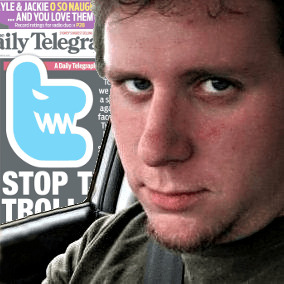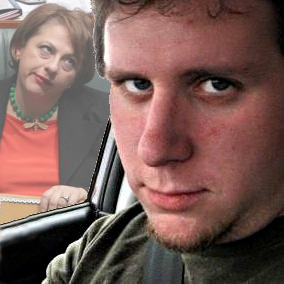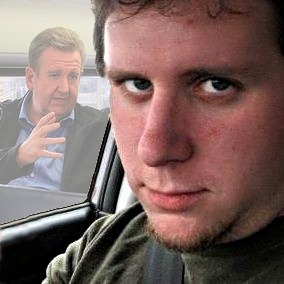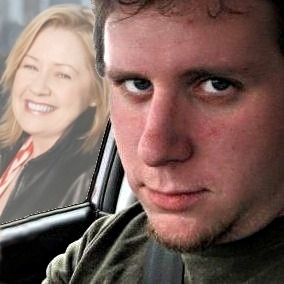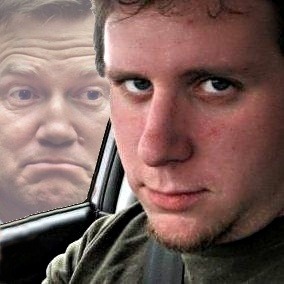Work experience kid slaving his guts out in the news and current affairs division of Aunty. It's not like they pay me, so these satirical thoughts are my own. Email: [email protected]
Don't wanna be here? Send us removal request.
Text
ABC Regional Division: Teaching alpacas how to knit socks
Anger at ABC over local news cuts: 'These stories simply won't be told' by Michael Lallo:
"They tell us a regional story should get up on its merits," says one senior source. "But unless it's a huge story, like Ballarat burning down, or a quirky story, like teaching alpacas how to knit socks, [they're not interested].
"You're missing a vast middle ground. That middle ground might be a report from an agricultural region – things that are central to how our economy functions.
"There's a real fear these 'middle ground' stories – which are so vital to the communities themselves – simply won't be told. The fear is we're effectively shutting the door on them."
Previously: On local news “ghettos”.
3 notes
·
View notes
Text
On local news "ghettos"
ABC audiences are set to lose the 7.30 state editions (still known as Stateline to connoisseurs), Radio National's Bush Telegraph, and numerous voices from regional areas.
During Estimates, executives explained that regional reporting resources (apparently a polite word for people) would not be lost, but that regional content (apparently a polite word for creative work) would be presented throughout the schedule, instead of being "quarantined" to regional-specific programming.
Director of Radio Michael Mason said:
In terms of the editorial reviews that happen at Radio National over the course of a given year, we felt that Bush Telegraph performed an important role, the content performed an important role, but we were in a way quarantining it, ghettoising it at 11 o'clock, which means other programs, such as Drive with Waleed, Breakfast with Fran, were not accessing and utilising rural and regional content as much as we would like.
Managing Director Mark Scott made similar comments about 7.30 state editions:
When there is a big [local] story breaking, we will be running a special one-hour edition of the seven o'clock news, combined with a 7.30 special.
…
A strategy that says, "Take your state based stories and, in a sense, quarantine them on a Friday night at 7.30, where the audiences aren't great and the audiences have drifted away from that timeslot" — is that the best way of making your investment or should in fact you follow those stories and run them when audience interest is bigger, on big news days, or run them in a timeslot where they are likely to attract a bigger audience?
These arguments certainly have merit, but they're perhaps most convincing as after-the-fact political rationalisation for controversial program changes. Which is appropriate for an audience at Senate Estimates.
But these arguments don't pay enough attention to the program audience.
—
The fact is, an editor or reporter will make different decisions based on their audience.
A report about the East-West Link for 7.30 Victoria will be different to one for the national program, and rightly so. A Victorian audience can do without copious background, while a national audience will need to know more than something-something-controversial-road-something.
In the new world order, a local story about Victorian issues will have to work for a national audience. How will stories be selected? Will they have to be of national relevance, or otherwise appeal to a national audience? How will stories be told? Will they have to include context so everyone else can keep up? The obvious answer to both of these questions is "yes", otherwise the program risks alienating its audience.
What of the suggested special one hour local editions of News and 7.30? Which stories will warrant that effort? Examples presented so far include things like elections, leadership changes, and natural disasters. (Silver lining: There'll be lots more of all of these!) Big events. You are not likely to see a local special for, say, the start of Ekka.
But that's what's so great about Stateline! (Fine, 7.30 state editions.) Last month, Crikey published a great piece by Glen Fuller and Andrew Nardi, in which they ran the numbers on 7.30 state edition stories. Data journalism on journalism data!
Half or more of the stories were about local, social, cultural, and educational subjects. How, if at all, would these be covered for a national audience? Try pitching a story about ACT primary school students learning African drums for a national program. You'll get two minutes, and that's if you're not bumped for Nutty the Squirrel.
These factors are even more extreme when attempting to integrate Bush Telegraph stories into flagship Radio National programs.
—
Yes, local stories deserve a national audience, but we also need local programs, telling local stories, for local audiences. Call it quarantining or ghettoisation if you like, but those are just impolite words for focusing on your audience.
—
The final 7.30 state editions air tonight. As national anchor Leigh Sales said on Twitter early this morning, "please tune in to give these programs a rousing send-off"!
(Did you know that the 7.30 state editions have been more popular than the national program in cities with a single daily local newspaper?)
6 notes
·
View notes
Text
On the ABC cuts
I'm sitting here upsetting myself with numbers.
Not just because I'm terrible at numbers, but because these numbers represent so much.
Quibble all you like about my priorities, tell me that 5% isn't much, that this government has cut other programs by more in the last year, and that commercial media organisations have lost more in the last ten… but I happen to be passionate about the ABC. I care about its work and its people. I care about what it can do that other organisations can't or won't. I care that it is a crucial part of Australian culture, expression, and democracy.
These are back-of-the-envelope calculations based purely on public sources. Don't depend on them for policy (or career) planning.
What are the cuts?
There are three:
A 1% efficiency dividend announced in the May 2014 budget as a "down payment" on further cuts.
An effective cut of about 2% due to the cancellation of the Australia Network contract by DFAT, announced in the May 2014 budget.
A cut of about 5% over 5 years, finally announced last week, which completes the "down payment".
How are they structured?
The 1% efficiency dividend was a 2014-15 budget measure, structured over 4 years. That's $35 million over 4 years.
The Australia Network was cancelled 1 year into a 10 year contract. It was given 90 days from the budget, but ultimately closed in late September 2014. Transition costs were underfunded by about $5 million, affecting the 2014-15 bottom line. There's $11 million listed in the 2014-15 budget for the Australia Network, but that's the wind-up.
The 4.6% cut is structured over 5 years, from $0 in 2014-15 to $68 million in 2018-19. But that 4.6% becomes about 5.1% when implementation costs are included, and they are generally most costly at the beginning of a transition (read: redundancies, cancelling contracts). It's highly likely that, much like the Australia Network transition, the government's estimate is lower than the actual cost of implementation, which will further affect the 2014-15 bottom line.
How does the ABC spend its money?
Here's some fast facts on how the ABC budget is spent, from the 2014 Annual Report.
Over 80% of government funding is spent on non-transmission related activities.
33.9% is spent on Television Programs Produced (including News)
18.8% is spent on Radio Broadcast (including News)
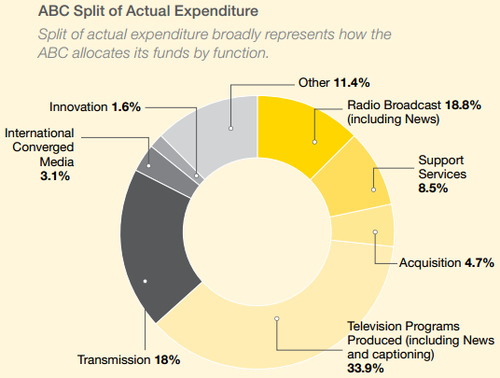
About 47% of government funding is spent on employees.
The ABC employed 5444 people, or the full-time equivalent of 4679 people
65% of ABC employees were directly involved in content making
51% of ABC employees work in NSW
22.48% of employees work in News
21.57% of employees work in Radio
19.58% of employees work in Resources
7.67% of employees work in Television
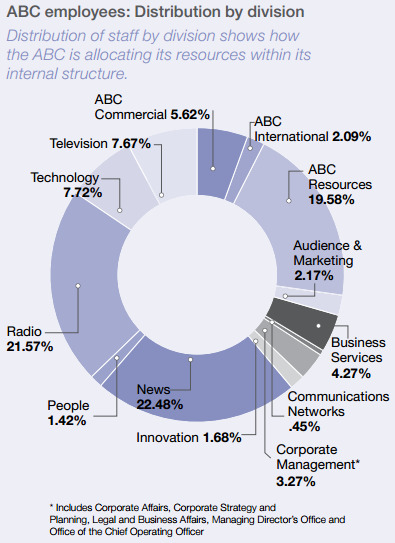
What efficiencies did the Lewis review identify?
The only practical information that we have about the Lewis review is that it identified about $59 million in potential annual recurrent savings, and it would cost more than $76 million to implement them. That's a rubbery figure, because those findings were never meant to be tallied up in the first place.
But it gives us an impression of the findings versus quantum of cuts. Over five years:
Lewis review, total: $219 million ($59 million each year, minus $76 million implementation costs)
Turnbull cuts, total: $295 million ($254 million over five years, plus estimated $41 million implementation costs… and there'll probably be more)
Again, it has to be stated that the Lewis review findings were not meant to be tallied like this. Without public access to the report, it's hard to say what a more realistic combination of the findings might look like, apart from "less than that".
But clearly, the Lewis review findings are insufficient numerical or political cover for the government's cuts.
Claims and counter-claims
Communications Minister Malcolm Turnbull claims that the Lewis review identified enough potential cuts to "back office" spending that ABC management would have no reason to cut programs. Indeed, he would like voters to blame management, not the government, if there are any cuts to programs.
On the other hand, Managing Director Mark Scott claims it's not that simple, that cuts to "back office" spending have an impact on the kind of content you can make.
For example, if you close a regional newsroom because you can't fund the supporting headcount, you are less likely to cover stories in that region, or covering them may be more expensive.
Another example is the Lewis review suggestion to abandon Digital Radio. That's going to save 2% of transmission costs (so about 0.38% of total budget), of which any savings go directly back to government anyway!
But if you don't spend any money on digital radio transmission, there's less incentive to invest in digital radio content like Double J. It would still be available via digital television and online streaming, but you can see the broader context of what might naively be regarded as "just back office" or "just infrastructure" cuts.
Which brings us to an important point: The only way Malcolm Turnbull's percentages add up is if his cuts apply to the total government funding of the ABC, including transmission costs. But those transmission costs are unlikely to change much, and as noted above, any savings there are owed to the government anyway.
So the 5% cut disproportionately affects the 80% of ABC expenditure not related to transmission, making it closer to a 6% cut (on average, over 5 years) on the things you care about, like people and programs, and everything that supports them.
To put this in context, CSIRO is suffering a 3% cut. The ABC is taking something closer to an 8% cut. Every agency has to do its fair share, right? No wonder so many people regard the ABC cuts as a punitive, political act.
How might the Turnbull cuts be distributed?
Until management proposals become public some time after 11am tomorrow morning, the most we have is rumours and the knowledge that cuts can't be distributed equally.
For instance, you can't just say, "Let's take that 6% out of People & Learning!" It represents 1.42% of employees and definitely less than 6% of expenditure of an organisation that is… shall we say… somewhat human resources challenged.
When it comes to content, consider television. It represents 7.67% of employees, but 33.9% of expenditure. How likely is it that there'll be a one-to-one relationship between those figures? Highly unlikely. The ratio between people and production is just so varied. "Redfern Now" has significant production costs, but the related ABC salaries support many other external productions. NewsCaff has a different balance.
It's also unlikely that you'd be able to cut half an employee, half a program, half a regional office, or half a newsroom. As a result, cuts tend to be more (for want of a better word)… coarse.
Cutting 6% of staff and production costs for one program might simply make it unviable, at least in its current state. It may be more appropriate to make substantial changes in one place, so that you can make smaller changes elsewhere.
That said, there's a lot of things we know won't be cut. Everything announced for the 2015 television slate, for example. That's all bedded down, production costs spent, etc., although they may suffer on the promotion front.
But the easiest, most politically palatable thing to cut is that which no one will miss: Development of new programs. It's great that the 2015 slate looks so good. What of 2016? What will we never see?
Monday
Early Monday morning, many ABC employees will discover the personal impact of these cuts. At 11am, staff around the country will watch an internal briefing by Mark Scott to find out management's cost-cutting proposals.
Although it has been called an all-hands briefing, it won't be everyone.
There'll be someone sitting behind the News 24 desk, and in the News 24 control room.
There'll be someone sitting behind a microphone and another behind a sound desk in every radio station around the country.
There'll be someone making sure that everything's on air, that all the automated control systems are working, and that web sites are online.
There'll be sleep to recover after working a shift that is incompatible with humane office hours.
There's studio time booked, programs to shoot or record, sets to bump in and out, vision to edit, packages to file before deadline.
Employee and supplier contracts to check, redundancy cheques to cut.
Locations to get to, people to interview, sound to record, vision to shoot, stories to be told, events that won't wait, reports to file, live crosses to schedule and meet.
There's mail and visitors to accept, phones to answer… and so much more.
These staff, doing their jobs knowing that changes are unfolding without them, will have to watch the briefing afterwards. They'll have to catch up later to process everything with their colleagues.
Much like there were ABC staff doing their jobs on Friday, Saturday and Sunday, knowing they had ominous meetings booked for early Monday morning.
And there'll be former staff -- including 80 lost in September when the Australia Network contract was cancelled -- watching old colleagues go through the same thing they did.
It's not going to be a pleasant Monday.
But at least we'll finally know exactly who and what we're fighting for.
31 notes
·
View notes
Photo

Bill Shorten: Speak & Spell
3 notes
·
View notes
Text
Pro-actively leaked emails, Big Bear and ABCnewsIntern
From: Big Bear To: ABCnewsIntern Subject: Coffee?!
Not up to the usual standard. My entire office is complaining. Did you… did you bring us coffee from A1?
From: ABCnewsIntern To: Big Bear Subject: Re: Coffee?!
No, I would never! I just thought it would be a funny practical joke to put Mecca coffee in A1 cups. Like… a Halloween trick?
From: Big Bear To: ABCnewsIntern Cc: People & Learning Subject: Re: Coffee?!
That's not even a thing. See me after drinks.
4 notes
·
View notes
Text
Halloween costume idea: ethics in video game journalism. Dress up as literally anything you want and then insist to the other party guests in an increasingly indignant tone that your costume is actually ethics in video game journalism.
4K notes
·
View notes
Text
Gutless and gloating
Gutless…
The opposition says it still has "anxieties" over the controversial policy of turning back asylum seeker boats but says it "might" continue the practice in Government if Indonesia backed the idea.
… and gloating:
But Mr Marles insisted on Sunday that the Coalition's success in "stopping the boats" was partly due to Labor's eleventh-hour policy to prevent all asylum seekers ever being resettled in Australia, even if found to be refugees.
Competitive inhumanity!
5 notes
·
View notes
Text
Whitlam, Shorten, and the Pharisees
It is manifestly unfair to compare Bill Shorten to Gough Whitlam, but in the days following Whitlam's death, such comparisons naturally accompany a remembrance and yearning for a more courageous politics in our nation.
So the timing of Bill Shorten's keynote speech to the Australian Christian Lobby's National Conference was, perhaps, unfortunate.
It's a good speech. Anyone who steps into the temple of the Pharisees and gives them a good bollocking, in their own terms, on their own turf – opening with the Sermon on the Mount and closing with John Wesley – is doing good work. (God's work?)
Shorten's speech and commitment to marriage equality will be hailed as an act of political courage. It might be compared, even favourably, with Whitlam's 1964 "Two Labor Parties".
But Whitlam's speech showed courage of vision. Shorten's, merely the courage of venue.
The Australian Christian Lobby is a fringe group, even among Christians. They represent an authoritarian, unforgiving dogma, inspired more by the Old Testament and cultural conservatism than Christ's message of love and charity.
In September 2012, I searched through the ACL's press releases to put some numbers on what they actually talk about while claiming to represent Australian Christianity. It wasn't pretty.
In a world needing help, afflicted with growing inequality, crippling addiction in many forms, adverse mental health, loneliness and disconnection from community, the ACL is obsessed with marriage and sex. Or, at least, the marriage and sex of a small proportion of the population.
To put their obsession in perspective: There are substantially more – arguably ten times more – Australians living below the poverty line than Australians likely to want a same sex marriage.
And yet, a majority of Australians support marriage equality. A majority of Christians support marriage equality. Three quarters of us believe that marriage equality is inevitable. Almost all Australians want legal recognition of same sex relationships.
When Shorten told off the Australian Christian Lobby for their meanness of spirit, he had the majority of Australians, the winds of generational change, and sheer power of inevitability behind him.
Backing equality is the price of entry to decency. Even facing a tough crowd, supporting marriage equality is not a matter of political courage today. Especially when Labor's policy itself is an equivocation, pledging only to have a conscience vote.
But there is another issue deserving of Christian charity that, because of the hardness of our hearts and politics, demands leadership and the courage to take a political risk: Our mistreatment of asylum seekers.
I ask you: what is the sin of these innocent children?
Those are not the words of Jesus, brought to us via Wycliffe, Tyndale and so many others, but of a mother held in detention on Nauru.
Today.
10 notes
·
View notes
Photo
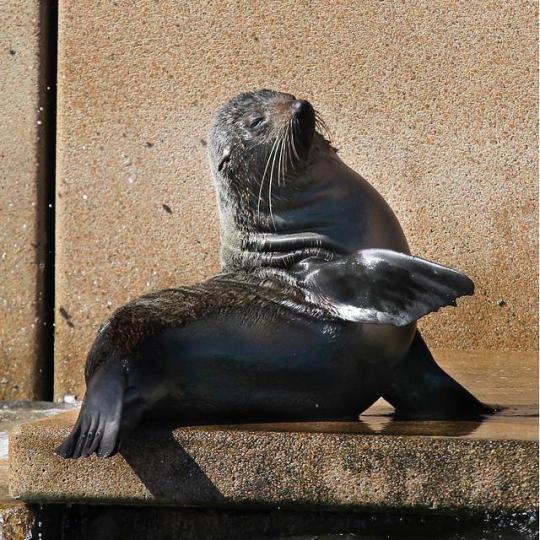
"But it's Friday, you're supposed to be at work!" "Look at all the fucks I give."
(•_•) <) )╯all the single ladies / \ (•_•) \( (> all the single ladies / \ (•_•) <) )╯oh oh oh / \
Sunbakers gonna bake, bake, bake, bake, bake. I'm just gonna shake it off!
6 notes
·
View notes
Text
Mental As… My Left Buttock
In case you missed it…
If we can raise just $1 for every one of my Twitter followers during Mental Health Week, I'll get a Lissajous — the ABC logo! — tattooed on my left buttock.
Remember, a tattoo dare is win-win: If you like me, you're supporting a good cause. If you don't like me, you're inflicting near-direct physical pain.
Donate now!
8 notes
·
View notes
Text
The Courier Mail Fauxpology

Just in case you missed the apology hidden between the lines of The Courier-Mail's statement above, I've transcribed and translated it here for you.
Mayang Prasetyo was the innocent victim of a horrendous crime, killed by the man she should have been able to trust the most.
If you don't remember who we're talking about, it's the murdered woman we referred to yesterday as a she male, lady boy, and high-class prostitute. Only we put quotes around high-class because that's how she advertised her services and it's obviously the most offensive part of the phrase high-class prostitute.
She should be remembered – as we reported yesterday – for her cheerful and friendly disposition, and for the care she had showed her family and loved ones in Indonesia.
We felt her cheerful and friendly disposition was best represented by borrowing scantily-clad bikini pictures from her Facebook account to plaster all over our front page. Then after briefly quoting her mother, we threw in a few more gems from Mayang's online advertisements for good measure.
Many believe that yesterday we presented Mayang's story in a way that was disrespectful to her memory.
One of our advertisers called.
The Courier-Mail had no intention of diminishing the value of Mayang's life, or to add to the grief being felt by her family.
Intending to sell a shit-tonne of newspapers with a salacious front page is a victimless crime. Wait, do they have the Internet in Indonesia? Shit.
49 notes
·
View notes
Photo

If we can raise $1 for every one of my followers during Mental Health Week, I'll get a lissajous — the ABC logo! — tattooed on my left buttock.
Remember, a tattoo dare is win-win: If you like me, it's support for a good cause. If you don't like me, you're inflicting near-direct physical pain.
I don't currently have any tattoos, never thought I'd ever get one, and yes… I will provide before and after photographic proof.
DONATE NOW!
9 notes
·
View notes
Text
A little story about my profile photo… and mental health?
Last week we observed World Suicide Prevention Day and RUOK Day. Next month will include National Mental Health Week, which coincides with World Mental Health Day, along with the ABC's contribution in the form of the Mental As campaign.
So, while I happen to be opening the kimono elsewhere, it seems like an opportune time to tell you a little story about my profile photo…
Hey, what on Earth does that have to do with mental health? Read on!
It was August 2010, and I had been thinking about making a silly Twitter account for a while. Once I had decided upon the low status character of an intern at the ABC, I thought I might draw (or commission!) a cartoon of a stereotypical pimply-faced work experience kid.
Patience failed me on the night of Tony Abbott's "I'm not a tech-head" interview.
I fossicked through Google Images for something amusing. I'll admit, my first search terms were "pimply faced youth".
For Brandon and I, it was love at first sight.

The blank(ish) expression, Mona Lisa smile, cynical eyes, boyish tuft of facial hair, and his "I'm not even supposed to be here today" double-barrelled finger-gun. You had me at hey-oh!
In November 2009, poor Brandon was stuck on a trip from Colorado through Nebraska, as blogged by his partner Amanda:
That’s right – it’s Nebraska. Endless hours of unbelievably deserted flatland and (lucky us!) grey skies. Brandon’s not afraid to show how he really feels.
In August 2010, poor Brandon was unknowingly co-opted into a very silly scheme on the other side of the planet. Introducing… ABC News Intern.
01:40 and still scrubbing the #730reportland set after the Abbott interview. This was so much easier back when it was red. #ausvotes
— ABC News Intern (@ABCnewsIntern)
August 10, 2010
This is the original profile picture:

Something clicked, because the intern gained 500 followers in 20 hours. To put that in context, it's averaged 500 new followers per month since it began.
In March 2011, Chris Wagner — then of Lifeline, now of Mental Health Australia — made a challenging suggestion:
#stigmawatch can @ABCnewsIntern please change his profile picture, it's actually not very appropriate when #suicide kills 2200 a year in Oz
— Chris Wagner (@mrchriswagner)
March 14, 2011
Friends, @mrchriswagner of Lifeline suggests I change my profile picture (holding finger "gun" to head) for #stigmawatch. What say you?
— ABC News Intern (@ABCnewsIntern)
March 15, 2011
After a fascinating discussion between Chris, myself, and my followers, I switched to a photo of Darth Vader — a running gag tribute to the long-suffering Alan Sunderland — and pondered what I might do next.
On one hand, it's just a silly visual gag in a photo. On the other, suicide is a growing problem, and absolutely serious. I could have dismissed Chris's suggestion as humourless "political correctness", but the more I thought about it, the more it made sense.
I strongly believe humour can be applied to any topic, no matter how dark or challenging. But it's hard to get right. Incredibly hard. Are you punching up or down? Elucidating, or intimidating? Exposing essential truths, or perpetuating stereotypes?
Look at the trail of careers (comedy and otherwise!) destroyed by attempted jokes about race, sexuality, illness, rape, death… come at the king, you best not miss.
So, a flippant visual gag that invokes suicide and self harm? No thanks.
Step 1, ditch the finger-gun. Photoshop time! It turned out okay. If you hadn't seen the original, you probably wouldn't even guess it had been modified.

@ABCnewsIntern hang on, where did the gun go?
— Virginia Trioli (@LaTrioli)
March 16, 2011
Step 2, check out that window! I'm a big fan of white space, but that looks like a joke-shaped hole. And so, the first of my leering window visitors arrived.

@ABCnewsIntern by the way mate, thanks for taking this seriously enough to start a convo, you're the future of journalism in OZ #mhsm
— Chris Wagner (@mrchriswagner)
March 15, 2011
There have been numerous callers at my window since 2011…
And finally, what it looks like today. Peta Credlin has been looming for a while now…
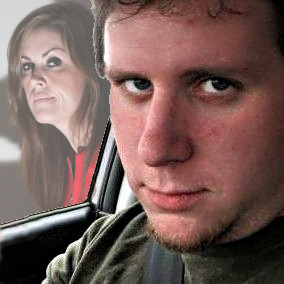
Since dropping the finger-gun, I've taken the opportunity to write the occasional thought about mental health issues. It's something a touch more serious than the regular hijinks… a weightier subject I can write about with some experience.
Hopefully it's helpful to some of my followers, and even educational for others?
If you, or someone you know, needs help you can call Lifeline on 13 11 14, or Kids Helpline on 1800 551 800.
34 notes
·
View notes
Text
Why do you think misogyny and sexism is so prevalent on Twitter?
They’re no more prevalent on Twitter than society at large, which is to say, endemic.
The difference is friction, or cost, of communication. It’s easier to express misogyny or sexism on Twitter because you don’t have to, say, go to the effort of shouting at someone in the supermarket, or walk down the street to buy stationery, a stamp and envelope and put your letter in the post box.
Responsibility and consequences are also a cost of communication. It’s easy to blame anonymity for bad behaviour online, but true anonymity is prohibitively difficult to achieve, and lots of people are entirely comfortable putting their name to awful views.
Consider the recent bout of imploding Liberal candidacies in Victoria. Their unpleasant use of social media had real consequences because they chose to become public figures. Most online abuse happens without repercussions because it’s committed by, well, no one particularly interesting.
– from Ten Questions: @ABCnewsIntern
9 notes
·
View notes
Photo
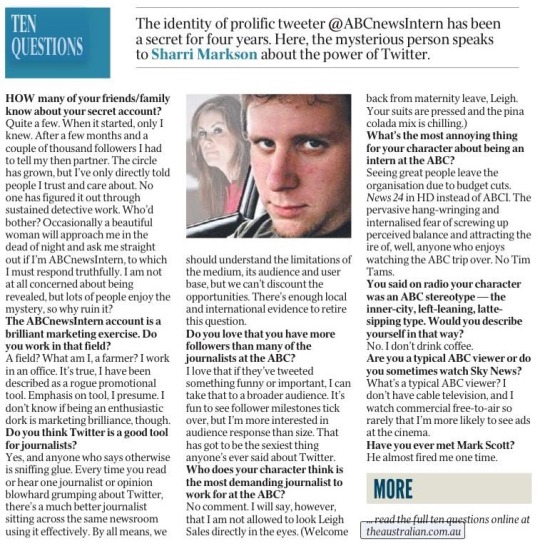
I did Ten Questions for The Australian with Sharri Markson. There were 9 published in the paper, and 26 published online. Don't think about it too much.
6 notes
·
View notes
Photo
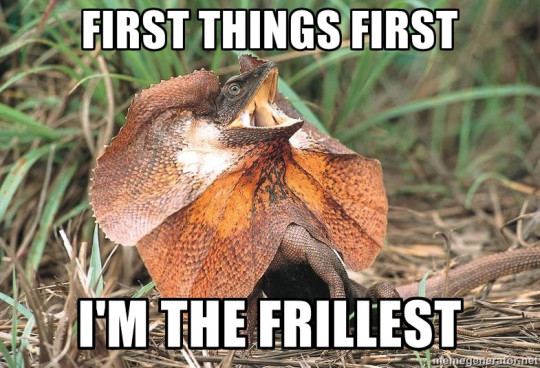
First things first, I'm the frillest.
10 notes
·
View notes

